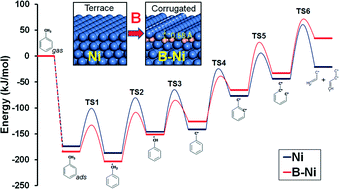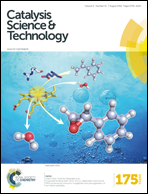Mechanistic insights into the catalytic elimination of tar and the promotional effect of boron on it: first-principles study using toluene as a model compound†
Abstract
Tar is the undesired viscous black liquid produced during the gasification of biomass. Catalytic elimination of tar is feasible and is economically promising. In the present investigation, we performed first-principles calculations (i) to elucidate the decomposition mechanism of tar on the popular nickel (Ni) catalyst and (ii) to reveal the promotional effect of boron (B) in improving the activity and stability of the Ni catalyst for tar decomposition. Being the most abundant component of tar, toluene was chosen as a model compound. On the Ni(111) surface, toluene adsorbs strongly in a bridge configuration and the activation barrier for methyl C–H dissociation is 72 kJ mol−1. Toluene can further decompose on the Ni(111) surface via stepwise dehydrogenation of the methyl group. The aromatic C–H bond at the ortho position could only be activated after the complete dehydrogenation of the methyl group, which is followed by subsequent ring opening (activation barriers are 112 and 84 kJ mol−1, respectively) and C–C cleavages, to generate smaller hydrocarbons. The incorporation of subsurface B into the Ni catalyst (B–Ni) results in a corrugated Ni top surface and toluene adsorbs more strongly by 11 kJ mol−1 on the B–Ni catalyst than on pure Ni. Although the mechanism of toluene decomposition remains unchanged after doping with boron, the decomposition of toluene is significantly promoted on B–Ni. The activation barrier for the first methyl C–H dissociation on B–Ni is reduced to 51 kJ mol−1. Subsequent methyl C–H activations are also promoted on the B–Ni catalyst, but to a smaller extent. The aromatic C–H activation is also strongly promoted (89 kJ mol−1vs. 112 kJ mol−1 on pure Ni). Additional calculations on stepped surface models of Ni show that the activation barriers of toluene decomposition on the B–Ni surface are very close to those on B5 and F4 step sites of pure Ni, thus suggesting that the promotional effect of B on the catalytic activity of Ni could be mainly attributed to the creation of step-like corrugations on the Ni surface. These corrugations could also inhibit the formation of graphene-like structures on B–Ni.


 Please wait while we load your content...
Please wait while we load your content...